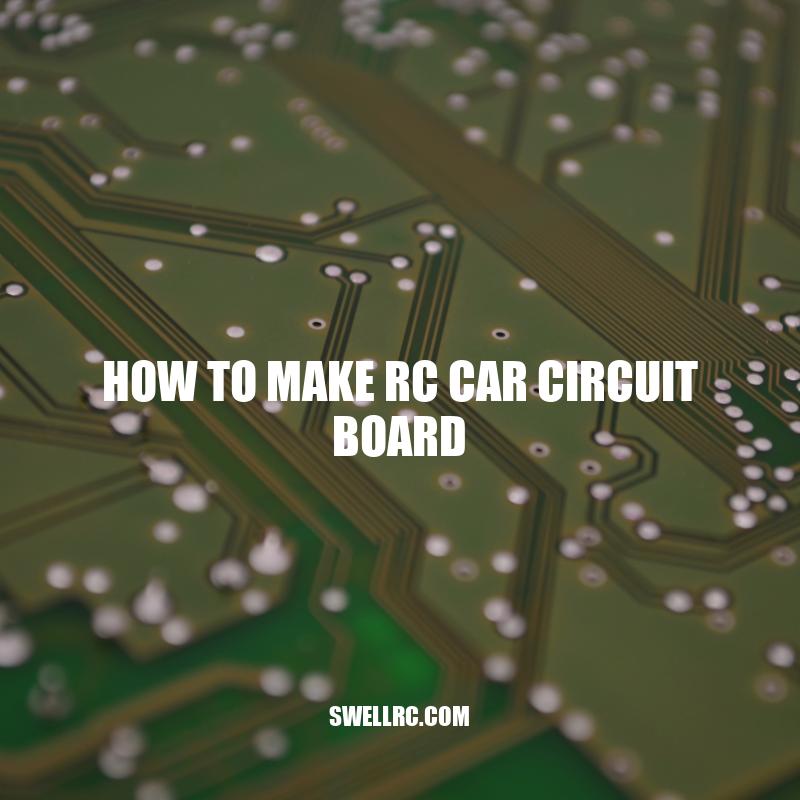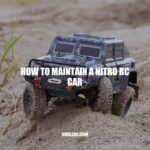DIY: How to Make an RC Car Circuit Board
Making a custom RC car circuit board is an essential part of creating a high-performance and reliable RC car. Without a properly functioning circuit board, an RC car cannot function properly, leading to a frustrating and disappointing experience for hobbyists. However, building an RC car circuit board is a process that requires patience, attention to detail and some basic knowledge of electronics. This article will provide you with a step-by-step guide on how to create an RC car circuit board that will meet your specific needs. The following instructions will guide you through the process of selecting materials, designing a circuit board, transferring the design onto the board, etching the board, soldering components and testing the board. While creating a custom circuit board may seem daunting, with the right tools and instructions, it can be a fulfilling and enjoyable experience. Follow this guide to create your own RC car circuit board, and get ready to enjoy a fully functional and high-performance RC car tailored just for you.
Gather Materials
To create a custom RC car circuit board, you will need some essential materials that can be found at your local hobby shop or electronics store, or can be purchased online. These materials include:
- circuit board
- copper etching solution (such as ferric chloride)
- permanent marker or toner transfer paper
- solder, soldering iron, and flux
- multimeter
- chemical-resistant gloves and eye protection
If you prefer to shop online, websites such as Amazon and Jameco Electronics provide a comprehensive range of electronic components and tools for creating custom circuit boards. It is important to note that the size, shape, and number of pins of the components that you need will depend on the design of your circuit board. Once you have gathered all the necessary materials, you are ready to begin the process of building your custom RC car circuit board.
How to make a circuit board for RC cars?
If you’re into the world of remote control cars, you know that making your own circuit board can be a fun and rewarding project. Here’s a brief overview of how to make a circuit board for your RC car:
- Design the circuit board using computer-aided design (CAD) software. There are free options available online, like KiCad or EasyEDA.
- Once you have the design, print it onto transfer paper or transparency film.
- Using a special iron or exposure box, transfer the design onto copper-clad board.
- Use an etching solution, such as ferric chloride, to remove the copper where you don’t want it.
- Drill holes in the board where needed and add any necessary components, like resistors or capacitors.
- Solder the components onto the board.
- Test the circuit board to ensure it works properly and make any necessary adjustments.
If you’re not comfortable making your own circuit board, there are companies that can create a custom board for you, such as PCBWay or JLCPCB.
Create a Design
Before creating the circuit board, you need to create a design to serve as a guide when placing the electronic components. Creating a circuit board design involves selecting the correct software, designing the circuit in the software, and selecting the size of the circuit board. Here are some key steps to consider when creating your custom RC car circuit board design:
- Select a PCB design software such as Eagle, KiCad, or Altium Designer, that is user-friendly and aligns with your needs.
- Draw your circuit diagram using the software. Ensure that the circuit that you have designed meets the requirements of your RC car.
- Select a suitable size for the circuit board that fits your desired dimensions.
- Use the software to place electronic components at appropriate positions based on the circuit diagram.
- Ensure that the positions of the components are spaced suitably with enough clearance between them for hassle-free soldering and proper connections.
- Double check your design for errors and make adjustments if necessary.
To help design your custom RC car circuit board, various self-help tutorials and online forums are available. Websites such as Instructables and Hackster offer step-by-step guides to PCB designing as well. Here’s an example of how your design can look like:
| Custom RC Car Circuit Board Design | |
|---|---|
| Size: | 3 x 3 inches |
| Components: | Microcontroller, motor driver, battery, resistor, capacitor |
| Positions: |
|
How to make a RC car design?
To create your RC car design, you will need to follow a few simple steps:
- Choose the type of RC car you want to build, such as a drift car, crawler, or touring car.
- Choose the chassis you want to use or build your own from scratch.
- Select the appropriate motor, ESC, and battery for your chosen RC car type.
- Choose the body style you want to use or create your own custom design.
- Select the appropriate suspension, wheels, and tires for your RC car.
- Add electronics for steering and other controls.
- Test and refine your design until you achieve the desired performance.
If you’re looking for products or tools to help with your design, check out websites like Tamiya or RC Planet for a wide selection of RC car kits, parts, and accessories.
Transfer the Design
Once you have created the circuit board design, the next step is to transfer it onto a blank copper-coated board. Transferring the design involves using heat to transfer the circuit layout onto the blank copper board to make a resist layer. Here are some key steps to consider when transferring the design onto the board:
- Print the design on a glossy paper using inkjet printing, make sure to print the mirrored design.
- Place the printed design, face down, on the copper board’s surface and iron it with a hot iron box or laminator. This will transfer the ink onto the board’s surface.
- Peel off the paper, and the design will be visible on the copper board’s surface in reverse. This will act as a resisting layer for etching.
There are other ways of transferring the design, such as laser printing, but ironing is the most common method among hobbyists. For successful transferring, pay attention to the printing properties, toner quality and the amount of heat and pressure applied.
If you are new to circuit board transfers, there are online resources that can help guide you. Numerous websites, like PCBWay and AllPCB, offer design transfer tutorials and tools to help with the process.
How do you transfer a circuit to PCB?
To transfer a circuit to a PCB, follow these basic steps:
- Create a schematic diagram of the circuit
- Transfer the schematic to a PCB design software
- Place and route the components on the PCB
- Generate Gerber files for manufacturing
- Send the files to a PCB manufacturer or use a DIY PCB kit to fabricate the board yourself
There are many PCB design software options available, including Eagle PCB and Altium Designer. Additionally, companies such as PCBWay and JLCPCB offer affordable PCB fabrication services.
Etch the Board
Etching is the process of removing unwanted copper from the circuit board while leaving the desired circuit layout intact. The etching process is simple but requires safety precautions to avoid chemical accidents. Ferric chloride is the most commonly used etching solution in hobbyist projects, and it’s available in powdered form or pre-mixed. Here are some key steps to consider when etching the circuit board:
- Mix the Ferric Chloride powder with hot water and stir until it dissolves completely.
- Place the board in the Ferric Chloride solution and stir gently to ensure the solution covers the entire board.
- Leave the board to etch, ensuring to check on it periodically until the unwanted copper is removed.
- Once the board is fully etched, remove it from the solution and rinse it with water. This stops the etching process and ensures a clean finish.
Additionally, when working with Ferric Chloride, be sure to follow all safety protocols because it is dangerous when exposed to skin and clothing. Protective gear, such as gloves and goggles, is necessary when etching to protect from chemical exposure.
If you prefer not to handle Ferric Chloride yourself, there are PCB manufacturing companies that can etch boards to your specifications. JLCPCB, PCBWay and OSH Park are examples of these companies. They offer various services, from PCB assembly to plastic injection moulding, and they often have fast turnaround times to deliver your customised board in a few days.
How do you make ferric chloride solution?
To make ferric chloride solution, follow these steps:
- Wear gloves and safety glasses to protect your skin and eyes.
- Add small pieces of ferric chloride to distilled water slowly, stirring constantly until the particles are fully dissolved.
- The recommended mixing ratio of ferric chloride to water is typically 1:1 or 2:1 depending on the desired concentration of the solution.
- If you are unsure of the right concentration for your purpose, seek guidance from a professional or take advantage of online resources to obtain instructions and safety tips.
Note that ferric chloride solution can be hazardous if not handled properly, so make sure to use it only in a well-ventilated area and dispose of it responsibly.
For those interested in purchasing ferric chloride solution, many chemical suppliers sell it online or in stores. Be sure to choose a reputable supplier that offers safety information and proper handling instructions along with the product.
Solder Components
Once the board is fully etched and rinsed, the next step is to solder the electronic components onto the board. Soldering is the process of melting a metal alloy with a low melting point using a heated iron to join two surfaces. For RC car circuit board soldering, these are the key steps to follow:
- Identify the position for each component on the board according to the design.
- Place the component on the board and hold in position with tape or a clip, ensuring that it’s aligned with the correct polarity.
- Heat the area of the pad or hole where the component is attached with a soldering iron.
- Touch the melted solder to the heated pad/hole, allowing it to flow around the component.
- Remove the heat source and hold the component steady while the solder cools and solidifies.
- Repeat this process to attach all components to the board.
It’s important to remember that soldering involves working with hot metals and tools, so be sure to follow all safety requirements to avoid injury.
If you prefer not to solder the components yourself, you can use PCB assembly services provided by JLCPCB, PCBWay, and other companies. These services ensure high quality soldering and accuracy, and they usually check all circuit board designs before assembly. Additionally, they offer stencil printing, which is useful in applying solder paste to the board before component soldering.
Test The Circuit Board
Before the custom RC car circuit board can be used, it’s important to test it to ensure it’s functioning correctly. The following testing steps can be taken:
- Check the board against the original design to ensure that each component is in its correct location, and that there are no bridges between copper traces.
- Use a multimeter to check for continuity on each part of the circuit board.
- Power up the RC car to determine if it’s functioning properly.
- Adjust any components or connections that are not working correctly based on the test results.
Companies like PCBWay and JLCPCB provide PCB testing services for customers. These services include visual inspection, AOI inspection, and functional testing. AOI inspection uses cameras to identify deviations in PCB features, such as short circuits, open circuits or missing components. This process helps to check errors following the circuit design. Functional testing involves ensuring that the final product functions as specified, simulating its operation to find any defects or issues.
In conclusion, creating a custom RC car circuit board requires time, patience, and attention to detail, but it can be a satisfying and enjoyable experience. With the right skills, tools, and materials, almost anyone can build their own circuit board. PCBWay and JLCPCB are great resources to use for PCB design and assembly services.
Can I make my own circuit board?
Yes, it is possible to make your own circuit board at home. Here are some resources to help you get started:
- Instructables has a step-by-step guide with photos on how to make a PCB at home.
- Wikihow also has a detailed tutorial on making a PCB using the toner transfer method.
- If you prefer video tutorials, GreatScott! has a great video on making your own PCB at home.
Conclusion
Making an RC car circuit board is a great way to enhance the performance and functionality of your RC car. It can also be an enjoyable and rewarding hobby. By following the steps outlined above, you can create a custom circuit board that meets your specific needs and preferences.
Remember to take the time to gather all necessary materials, carefully design your circuit board, transfer the design accurately, etch the board safely, solder components carefully, and test the board thoroughly before using it.
If you’re a beginner, don’t be intimidated by the process. There are many resources and tutorials available online that can help you learn and improve your skills. Additionally, companies like PCBWay and JLCPCB offer PCB design and assembly services, which might be a good option for those who need more guidance or support.
Whether you’re an experienced hobbyist or just starting out, building an RC car circuit board can be a fun and educational experience. By following the steps outlined above and exploring additional resources, you can create a custom circuit board that takes your hobby to the next level.



